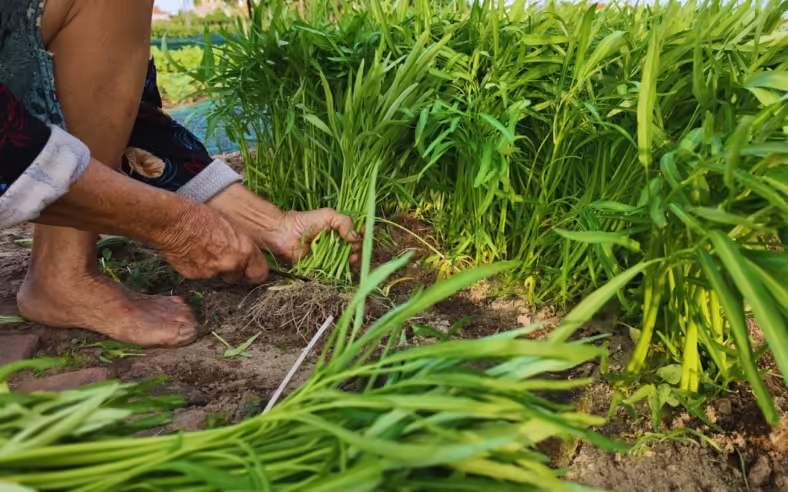
What Is Water Spinach? A Guide to This Asian Super Green
Have you ever seen long, hollow-stemmed greens in a stir-fry at an Asian restaurant and wondered what they are? That’s water spinach—also known as kang kong, ong choy, or rau muong in Vietnamese. Loved for its tender stems and fast growth, this leafy vegetable is a staple across Southeast Asia. In this article, we’ll explore everything you need to know about water spinach: its unique characteristics, how it’s grown and harvested, its nutritional benefits, and how it’s used in traditional Vietnamese cuisine.
What is water spinach
Growing and harvesting
Nutrition facts
Culinary uses
FAQs
What is water spinach?
Overview
 Vietnamese name: rau muong
Vietnamese name: rau muong Shape and appearance: Long, hollow stems divided by nodes, soft in texture, and green or purplish in color. Leaves vary in shape—some are arrowhead-like with pointed tips, while others are narrow and elongated.
Shape and appearance: Long, hollow stems divided by nodes, soft in texture, and green or purplish in color. Leaves vary in shape—some are arrowhead-like with pointed tips, while others are narrow and elongated.  Habitat: Grows both on land and in water.
Habitat: Grows both on land and in water. How to enjoy it: In Vietnamese cuisine, it’s commonly stir-fried with garlic, boiled and served with dipping sauce, or cooked into soup with shrimp.
How to enjoy it: In Vietnamese cuisine, it’s commonly stir-fried with garlic, boiled and served with dipping sauce, or cooked into soup with shrimp. Harvest season: Grown year-round in Vietnam, thanks to its fast growth and adaptability.
Harvest season: Grown year-round in Vietnam, thanks to its fast growth and adaptability.Two main types of water spinach in Vietnam:
There are two main types of water spinach in Vietnam: upland (dryland) water spinach, which is commonly grown in home gardens, and aquatic water spinach, typically grown in ponds or flooded fields, often with longer stems and the ability to be harvested multiple times. Both types are used similarly in cooking, though the aquatic variety is more common in large-scale farming.
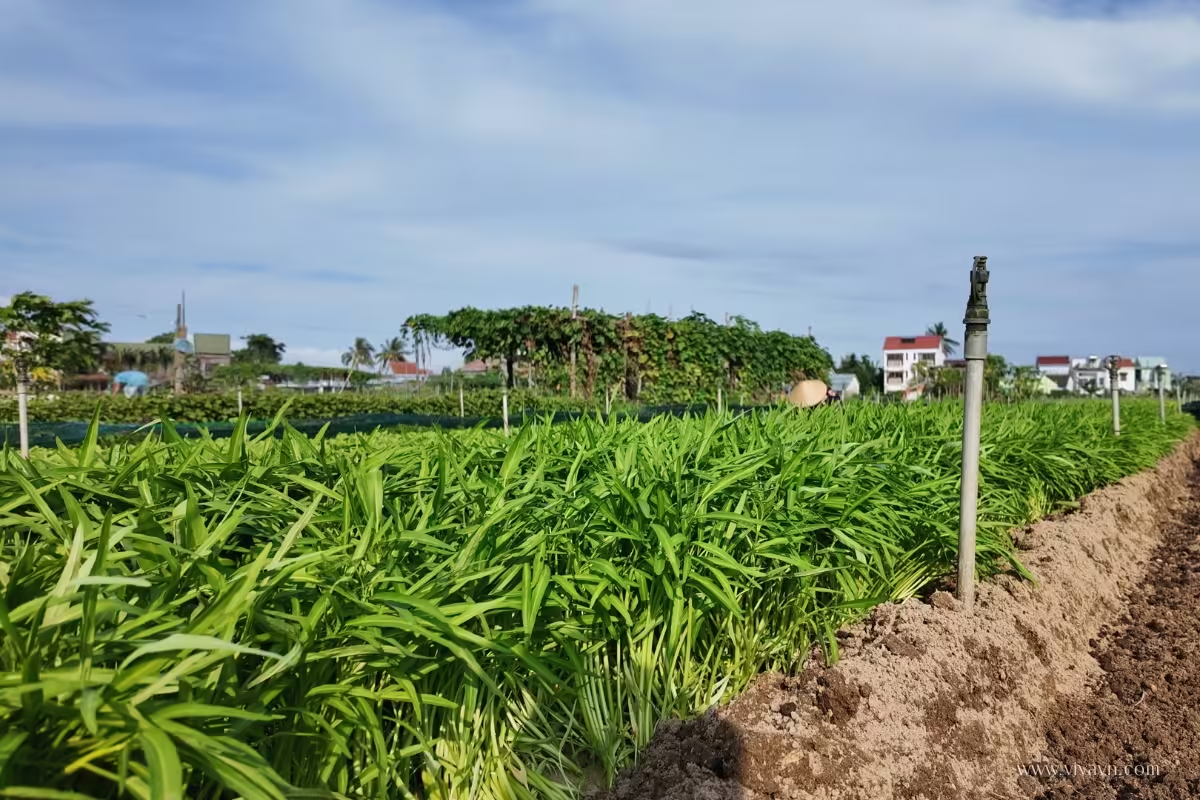
Image: A row of fresh upland Vietnamese water spinach growing in soil
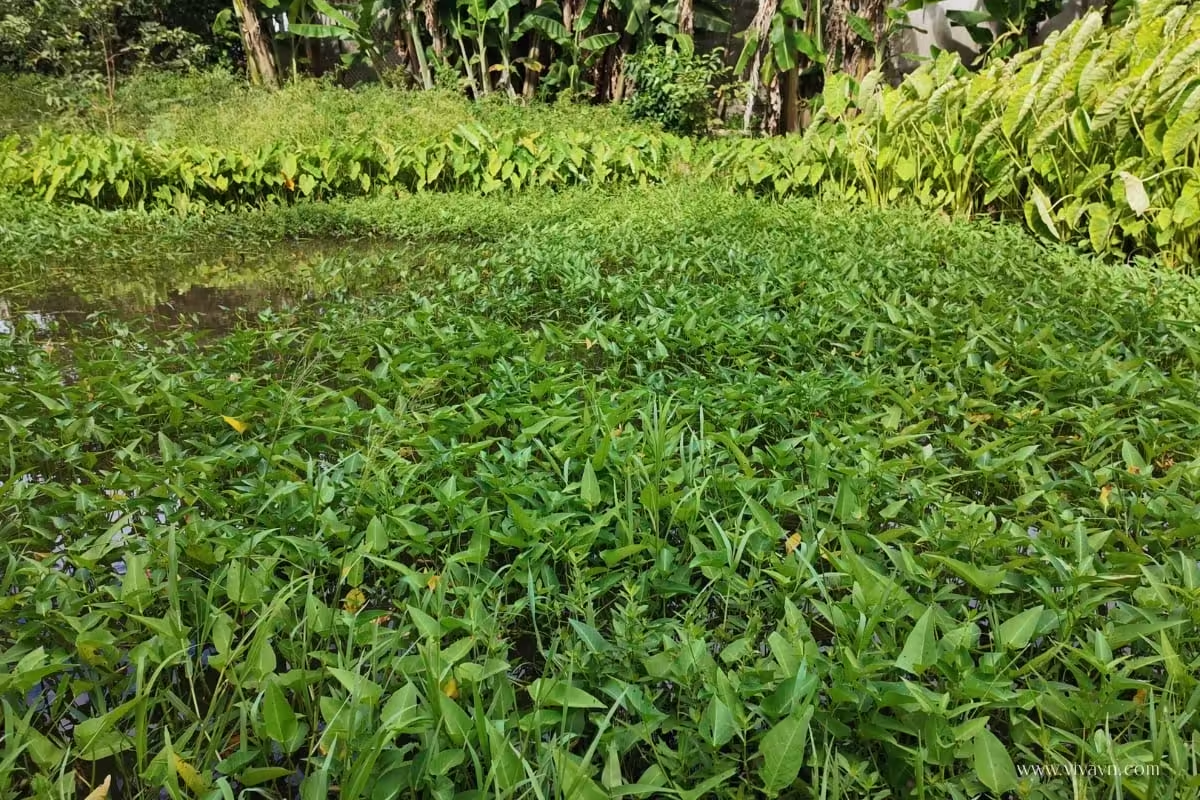
Image: Aquatic water spinach growing in a pond in Vietnam
Leaf shape: upland vs aquatic varieties
Depending on growing conditions, water spinach develops two distinct leaf types. The upland variety, often grown in soil, tends to have slender, elongated leaves. The aquatic variety, which thrives in water, produces shorter, arrowhead-shaped leaves with pointed tips.
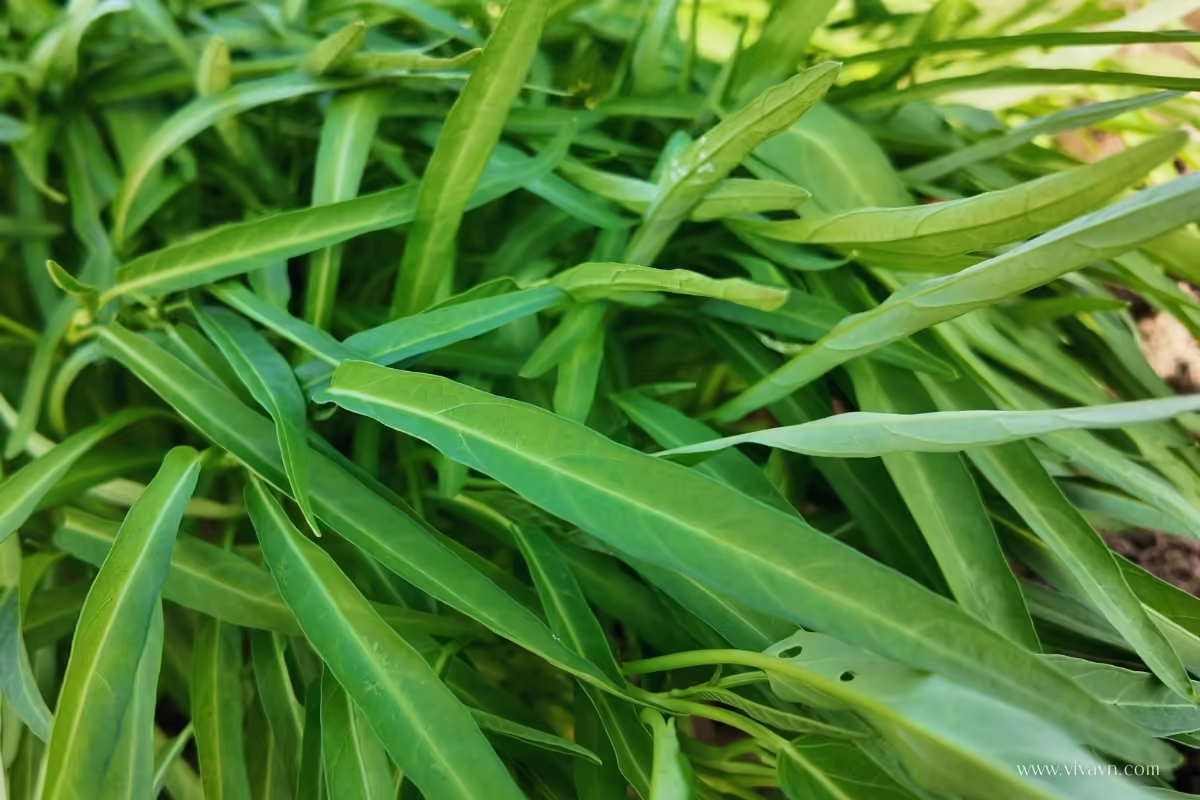
Image: Close-up of upland water spinach leaves—long, narrow, and vibrant green
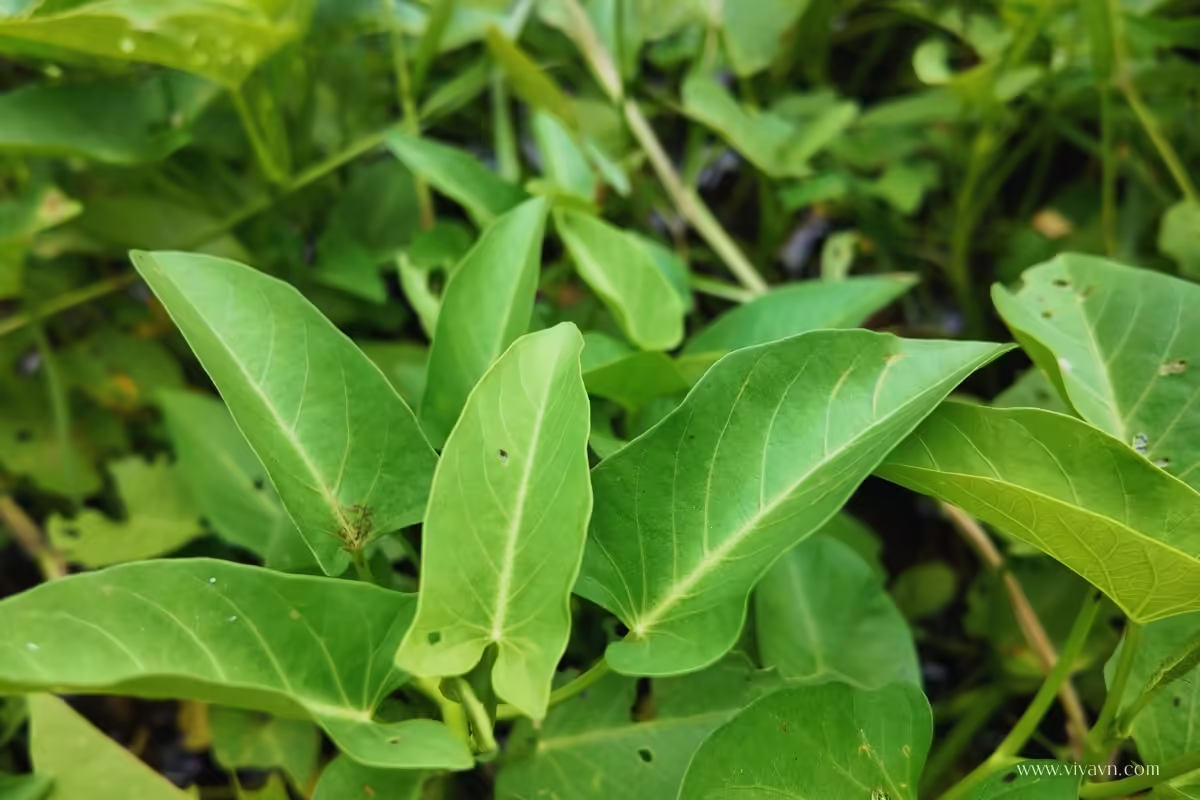
Image: Close-up of aquatic water spinach with arrowhead-shaped leaves growing in water
Stem characteristics: upland vs aquatic types
Both kinds of water spinach have hollow stems with clear segments. But the way they grow makes a big difference. The upland type, which grows in soil, has slimmer, straighter stems that are light green. The water-grown variety has thicker stems that are heavier and float on water. These stems can be green or purple.
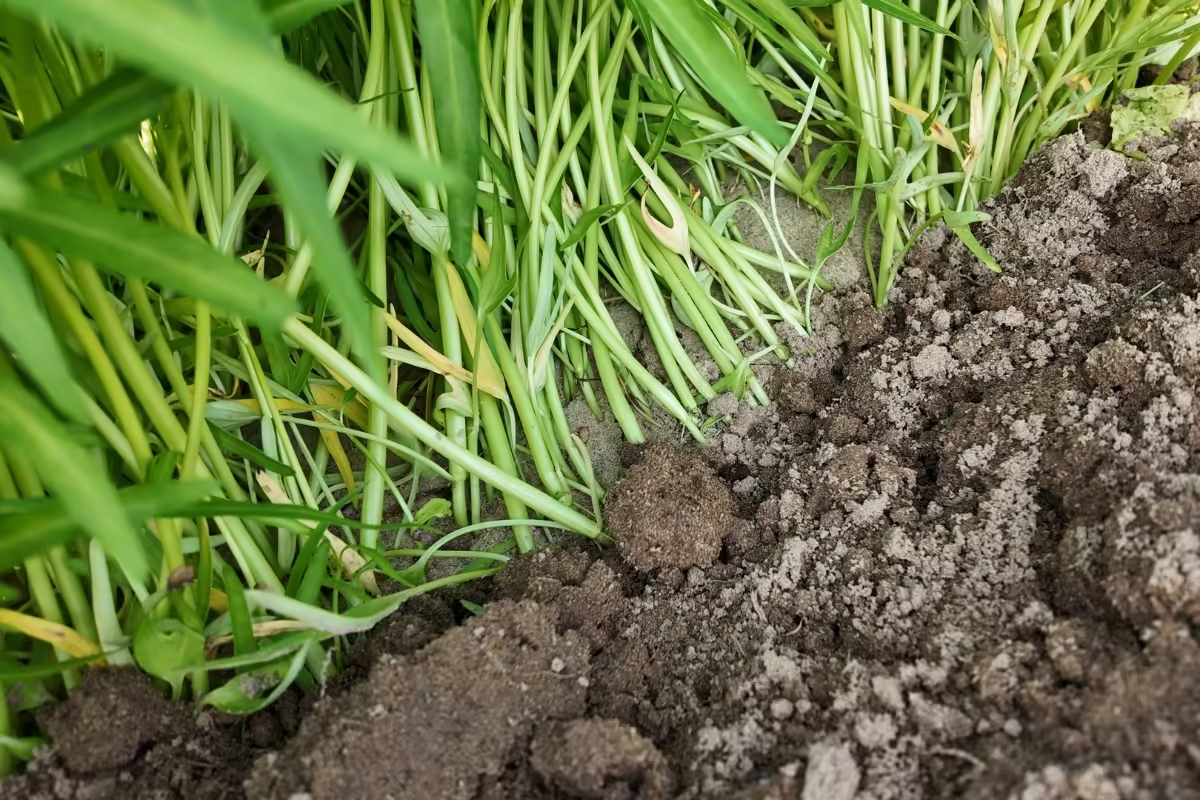
Image: Close-up of upland water spinach stems growing in soil
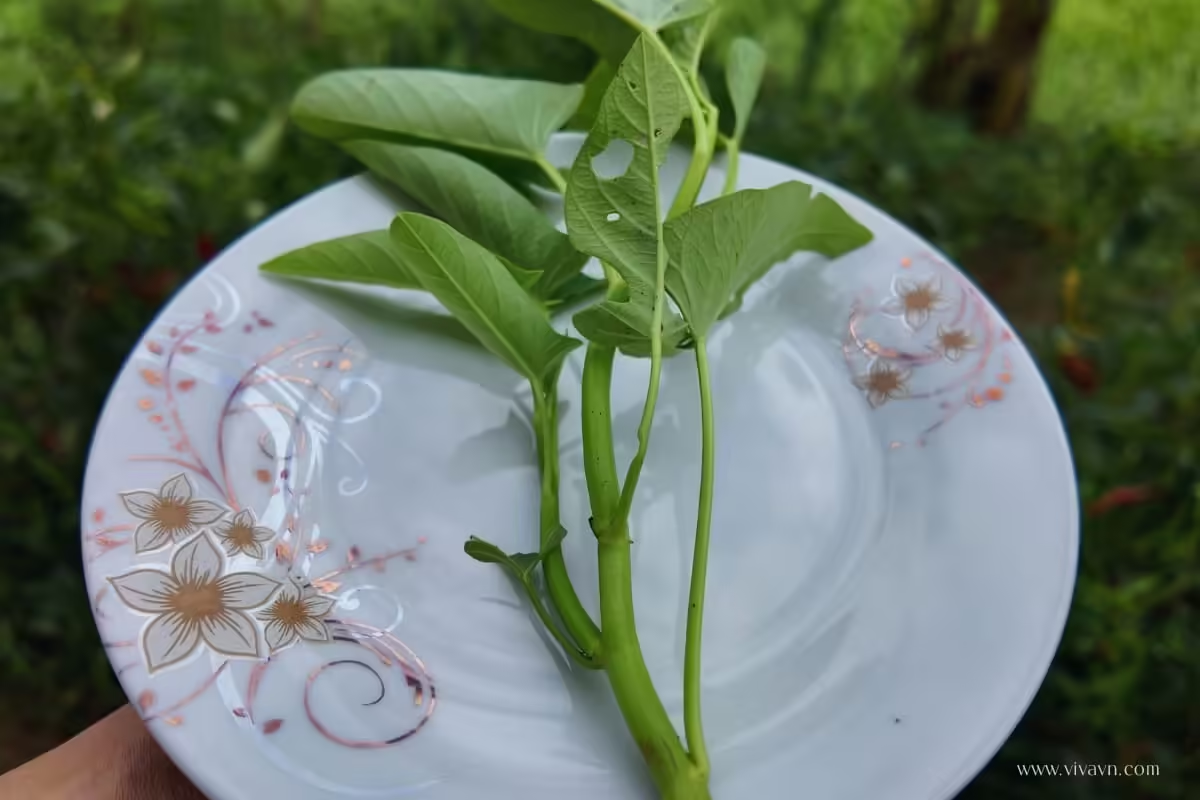
Close-up of aquatic water spinach stems growing in water
Cultivating and harvesting water spinach
In Vietnam’s tropical climate, water spinach grows easily, whether it’s cultivated on dry land or in wet conditions. Both types are typically grown from seeds, though the water-grown variety can also be propagated from cuttings. After just 20 to 25 days, the plants are ready for harvest. For upland water spinach, farmers usually harvest the entire plant.
But when it comes to the water-grown kind, they use scissors to cut the stems, leaving about 7 to 10 centimeters at the base. This allows the plant to regrow and be harvested again several more times.
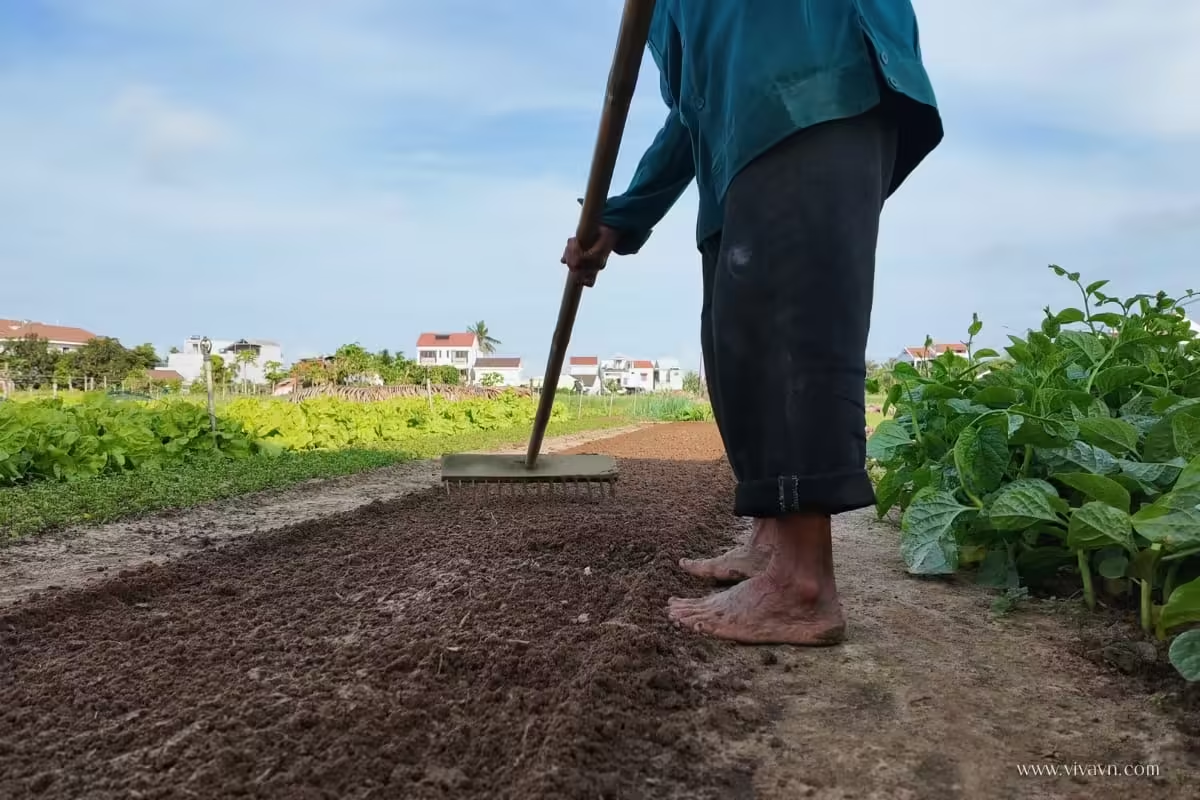
Vietnamese farmer preparing the soil for planting water spinach in a home garden.
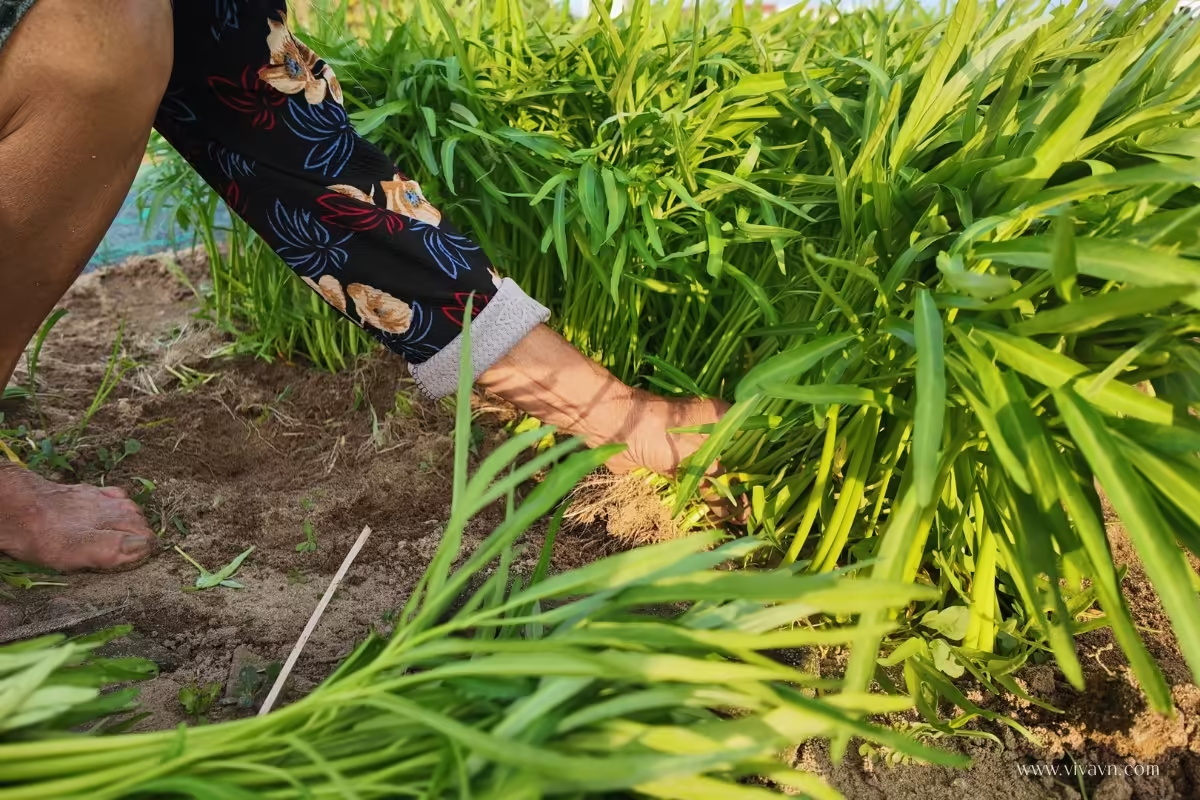
Vietnamese farmer harvesting upland water spinach by hand after 20 days of growth.
Nutritional benefits of water spinach
Water spinach isn’t just a popular leafy green in Vietnamese cuisine—it’s also full of nutrients that support overall health. With its high water content, low calories, and a good range of essential vitamins and minerals, this vegetable is a refreshing and nourishing choice in everyday meals.
Here’s the nutritional breakdown for a 3.5-ounce (100-gram) serving of raw water spinach (Ipomoea aquatica, also known as water convolvulus), based on USDA data:
| Nutrient | Amount | Notes |
|---|---|---|
| Water | 92.5 g | High water content helps keep you hydrated. |
| Energy | 19 kcal | A very low-calorie food. |
| Protein | 2.6 g | Provides a modest amount of protein. |
| Fiber | 2.1 g | Supports healthy digestion. |
| Vitamin C | 55 mg | Contributes to immune function. |
| Vitamin A (RAE) | 315 µg | Important for vision. |
| Potassium | 312 mg | Helps regulate fluid balance. |
| Calcium | 77 mg | Contributes to bone and dental health. |
| Iron | 1.67 mg | Needed for red blood cell production. |
| Magnesium | 71 mg | Plays a role in muscle and nerve function. |
Culinary uses
Water spinach is a staple in everyday Vietnamese cooking. It’s one of the most common leafy greens found in home kitchens and local eateries across the country. Despite being prepared in simple ways, dishes made with water spinach are packed with flavor, offering freshness and balance to the meal.
Stir-fried water spinach with garlic (rau muong xao toi)
This is one of those everyday dishes that feels comforting no matter how many times you’ve had it. The garlic is gently sautéed to bring out its aroma, then the water spinach is quickly stir-fried until tender but still crisp. Lightly seasoned the Vietnamese way, it’s a simple yet flavorful side that always hits the spot, especially with a bowl of warm rice.
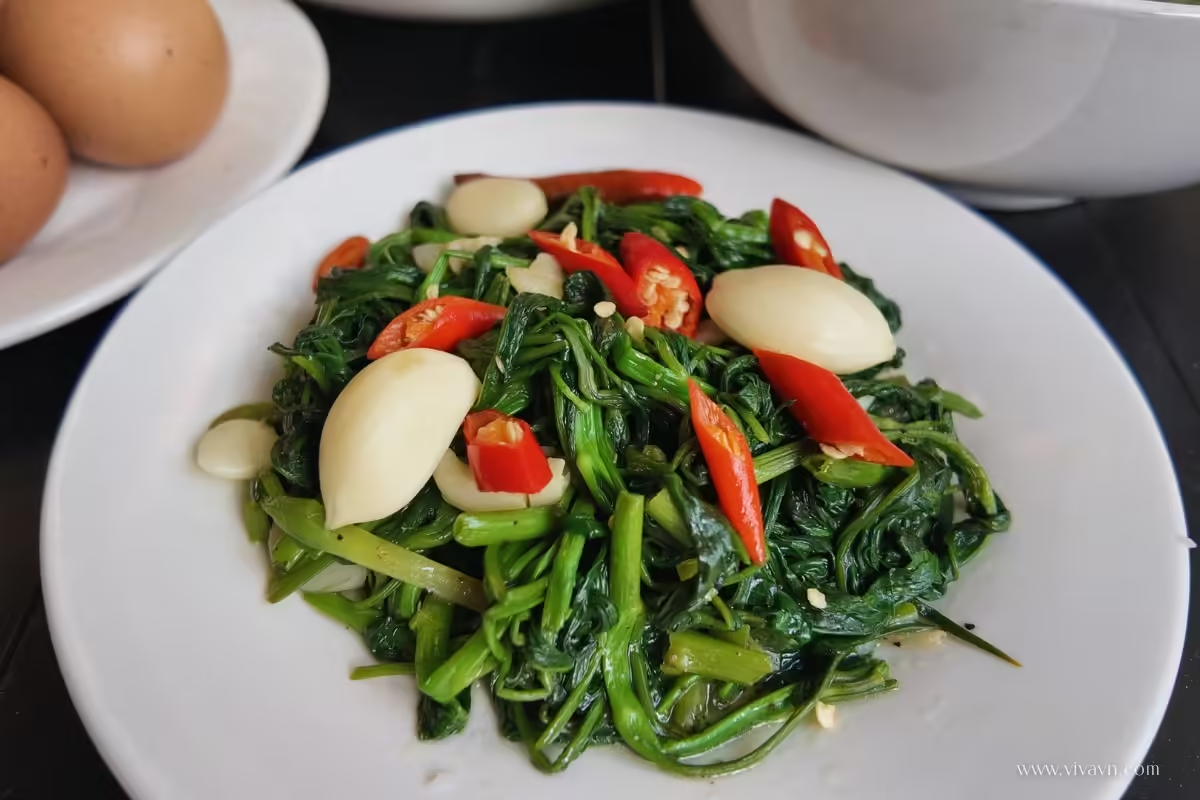
Freshly stir-fried water spinach with garlic—crisp, aromatic, and full of flavor. A beloved side dish in everyday Vietnamese meals.
Water spinach soup with shrimp (canh rau muong nau voi tom)
Water spinach soup with shrimp is a beloved everyday dish in Vietnamese homes. It’s light, flavorful, and comes together quickly—perfect for a family meal. The recipe starts with peeled shrimp, which are sautéed with garlic, shallots, and a touch of oil. A splash of fish sauce adds that signature depth of flavor common in Vietnamese cooking.
Once the shrimp are fragrant and just cooked, water is added to create the broth. Finally, fresh water spinach is tossed in and gently simmered until just tender. The result is a refreshing, slightly savory soup that pairs beautifully with steamed rice.
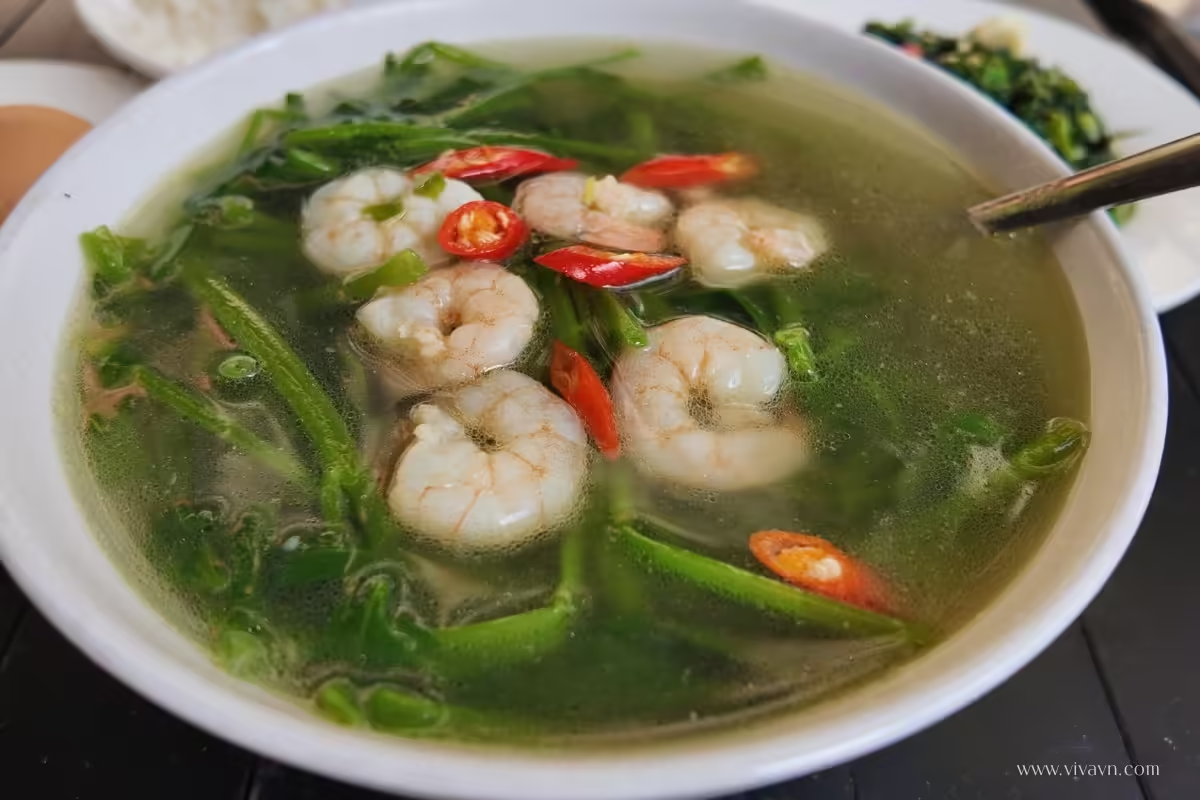
A classic Vietnamese soup made with fresh water spinach and shrimp—simple, nourishing, and full of flavor.
Boiled water spinach with soy sauce (rau muong luoc cham nuoc tuong)
Boiled water spinach with soy sauce is a humble yet delicious staple in Vietnamese home cooking. It’s incredibly simple: fresh water spinach is briefly boiled until just tender, then served with a small bowl of soy sauce for dipping. For extra flavor, thinly sliced garlic and chili can be added to the soy sauce, creating a savory and slightly spicy dip. This dish is often enjoyed with plain rice, offering a clean, refreshing contrast to richer main courses.
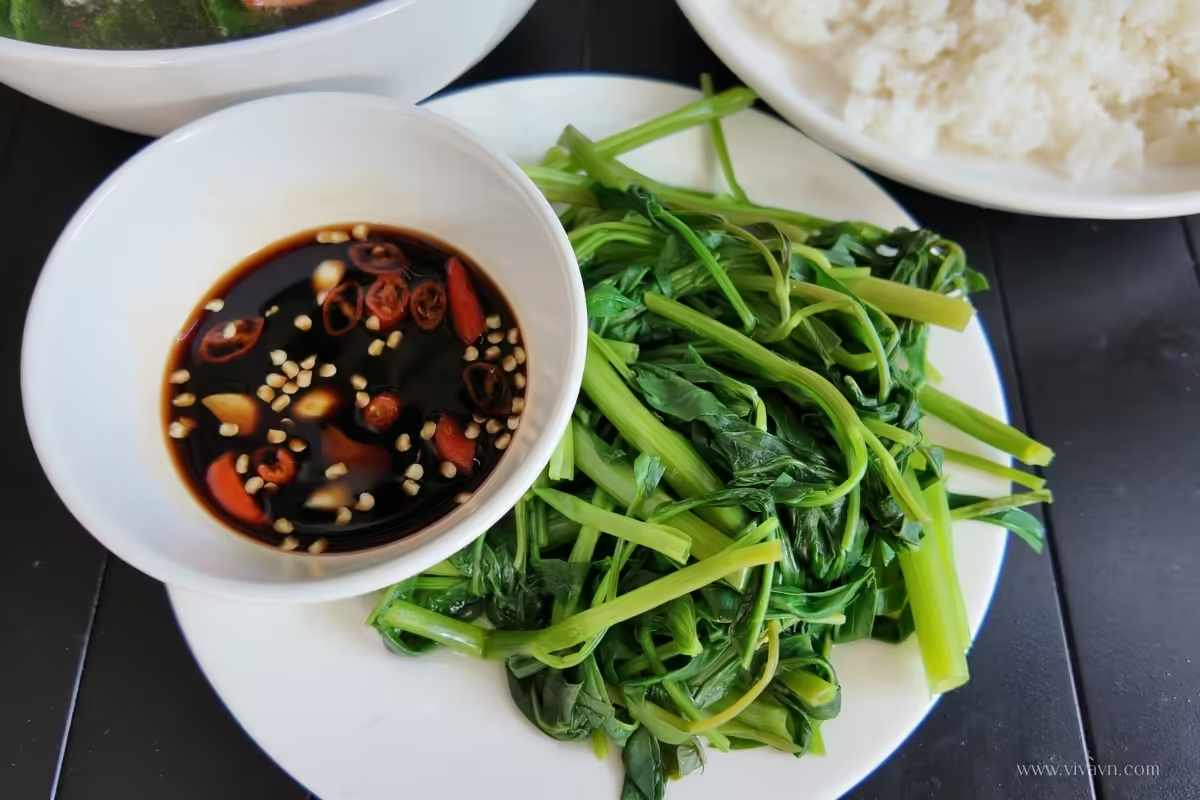
Classic Vietnamese side: boiled water spinach served with soy sauce, garlic, and chili
Frequently asked questions about water spinach
What is water spinach?
Known as rau muong in Vietnam, it’s got hollow, jointed stems and arrowhead-shaped or long, slender leaves. It grows like a weed – literally – in both waterlogged paddies and dry garden beds. Mild flavor, crazy versatility, and a staple in every Vietnamese home kitchen.
Are there different varieties of water spinach?
Yes, there are mainly two types: upland (dryland) water spinach with slender, elongated leaves, and aquatic water spinach with broader, arrowhead-shaped leaves.
How is water spinach commonly prepared?
It’s versatile in cooking—commonly stir-fried with garlic, added to soups, or simply boiled and served with dipping sauces. Its tender stems and leaves absorb flavors well.
Can I grow water spinach at home?
Yes, you can grow water spinach at home, especially if you live in a warm and humid place. It loves sunlight and grows well in moist soil or water. Just be sure to check your local rules first—some areas consider it invasive.
Is water spinach safe to eat raw?
While it’s possible to eat water spinach raw, it’s generally recommended to cook it to eliminate potential contaminants, especially if sourced from the wild or unknown water sources.
Share on FacebookShare on X (Twitter)Share on PinterestShare on WhatsappShare on LinkedinShare on TelegramShare on Email
- https://www.youtube.com/@VivaVNOfficial
- https://www.facebook.com/vivavnofficial2024
- https://www.pinterest.com/vivavnofficial/
© 2025 VivaVN. All rights reserved.

Leave a Reply